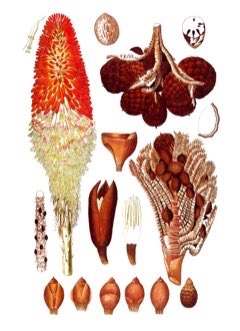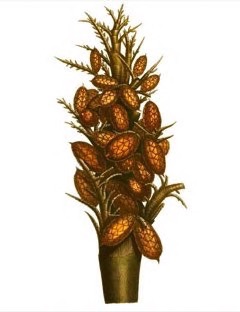 |
|
http://www.edibleplants.org |
 |
| http://www.edibleplants.org |
Translate this page:
Summary
Raphia farinifera or commonly known as Raffia Palm is a tropical palm tree endemic to Africa that grows up to 10 m tall and 60 cm in trunk diameter. It is a monocarpic species, which means that its individual stems only flower once then die. Flowering occurs when the tree is about 20-25 years old and it takes another 5 years from flowering to ripe fruit. The fruits are oblong to ovoid and covered with glossy golden brown scales. It can be eaten once boiled. The fruit also sources edible oil and edible seeds. Sap obtained from the trunk can be made into palm wine and sweet beverages. The stem, on the other hand, yield an edible starch. A commercially important and strong fiber known as raffia can be obtained from the leaves of this tree. It is used in weaving, thatching, hut construction, etc. Piassava, fibre obtained from the leaf sheaths, is used for making brooms and ropes. Lower surface of the leaves yield wax which can be used as a polish for boats and floors, and in candle production. Oil extract from fruit pulp and kernels is used in soap making. The wood is used for construction.
Physical Characteristics

 Raphia farinifera is an evergreen Tree growing to 25 m (82ft) by 18 m (59ft) at a fast rate.
Raphia farinifera is an evergreen Tree growing to 25 m (82ft) by 18 m (59ft) at a fast rate.
See above for USDA hardiness. It is hardy to UK zone 10.
Suitable for: light (sandy), medium (loamy) and heavy (clay) soils. Suitable pH: mildly acid, neutral and basic (mildly alkaline) soils. It cannot grow in the shade. It prefers moist or wet soil.
UK Hardiness Map
US Hardiness Map
Synonyms
Metroxylon ruffia (Jacq.) Spreng. Raphia kirkii Engl. ex Becc. Raphia lyciosa Comm. ex Kunth Raphia
Plant Habitats
Edible Uses
Edible Parts: Fruit Oil Sap Seed Stem
Edible Uses: Drink Oil Sweetener
The sap from the trunk is fermented to make palm wine[297 , 317 ]. It is also used to make a sweet beverage[301 ]. The sap can be obtained either by cutting down the trunk and allowing the sap to drain out, or by boring a hole in the trunk near the apex[297 ]. An edible starch is obtained from the stem[301 , 317 ]. Fruit - boiled and eaten[297 , 317 ]. An oil is obtained from the fruit[297 ]. The boiled fruit pulp yields a yellow fat known as raphia butter - it has a good taste when fresh[301 ]. The fruits are crushed, water is added and the mixture boiled then left to cool. The floating oil is then skimmed off and used in cooking[398 ].. The seed is edible[301 , 317 ].
References More on Edible Uses
Medicinal Uses
Plants For A Future can not take any responsibility for any adverse effects from the use of plants. Always seek advice from a professional before using a plant medicinally.
None known
References More on Medicinal Uses
The Bookshop: Edible Plant Books
Our Latest books on Perennial Plants For Food Forests and Permaculture Gardens in paperback or digital formats.

Edible Tropical Plants
Food Forest Plants for Hotter Conditions: 250+ Plants For Tropical Food Forests & Permaculture Gardens.
More

Edible Temperate Plants
Plants for Your Food Forest: 500 Plants for Temperate Food Forests & Permaculture Gardens.
More

More Books
PFAF have eight books available in paperback and digital formats. Browse the shop for more information.
Shop Now
Other Uses
Basketry Broom Buttons Containers Fibre Furniture Lighting Oil Raffia Soap making String Thatching Weaving Wood
Raffia, which is widely used in weaving to make baskets, mats etc, is obtained from the leaflets of this plant[297
].
The large midribs of the leaves, and the leaf stalks, are widely used by native people to construct the framework of houses, as poles for various uses and for making into furniture[297
]. They can be split into strips for weaving into mats, baskets etc[297
].
The leaves are used for thatching and weaving baskets, mats and hats[364
].
The fibres obtained from the leaves are used as tying material and for weaving mats, hoods, bags, curtains etc[317
].
The tough fibre (known as piassava) obtained from the leaf sheaths, is used for making brooms[297
]. A tough rope can also be made from this fibre[297
].
The fibre is derived from the cuticle of the leaves, which are harvested before fully expanded and peeled upon both sides. The thin strips of fibrous material thus obtained are afterwards divided into narrower strips by a kind of comb, according to the purpose for which they are to be used. It appears as flat, straw-coloured strips, about 12 - 18mm wide and from 90 - 120cm long. It is capable of being divided into fine threads. It can be used for delicately plaited goods, hats, mats for covering lloors, and for wrapping up goods. The loose strips are extensively used in place of Russian bast or tie bands by gardeners and nurserymen. More recently it has been woven into superior matting, tastefully coloured, and used instead of tapestry for covering walls in London houses[454
].
The preparation of raffia is one of the most extensive industries in Madagascar. The men cut the palm leaves in the forests and bring them home for the women to complete the work. The fibre is cured the same day it is stripped[454
] Among its native uses may be mentioned cordage and fishing nets[454
].
Raphia wax, which is derived from the lower surface of the leaves, is used as a polish for boats and floors or is utilized for the production of candles[317
].
The oil extracted from the boiled fruit pulp and the kernels of the fruits is used for the production of soap and stearin[317
].
The shells of the fruits are made into snuffboxes or buttons[317
].
Wood - used for construction[297
]. The wood can be used after the sap has been allowed to drain[297
].
Special Uses
Carbon Farming Food Forest
References More on Other Uses
Cultivation details
Industrial Crop: Fiber Industrial Crop: Wax Management: Standard Regional Crop Staple Crop: Oil Staple Crop: Sugar
A plant of the tropics, it is able to succeed in subtropical areas. Plants succeed in moist tropical climates where temperatures never fall below 10?c, the average annual rainfall is 1,500mm or more and the driest month has 25mm or more rain[297 ]. Requires a sunny position in a wet soil[314 ]. A monocarpic plant - growing for several years without flowering, then producing a massive inflorescence and dying after setting seed[200 ]. Flowering Time: Early spring, Late spring, Mid spring. Bloom Color: White. Spacing: 20-30 ft. (6-9 m) 30-40 ft. (9-12 m) over 40 ft. (12 m).
Carbon Farming
-
Industrial Crop: Fiber
Clothing, rugs, sheets, blankets etc. Currently, almost none of our fiber are produced from perennial crops but could be!
-
Industrial Crop: Wax
Water resistant, malleable substances. Currently, most commercial wax is made from paraffin - a fossil fuel.
-
Management: Standard
Plants grow to their standard height. Harvest fruit, seeds, or other products. Non-Destructive management systems.
-
Regional Crop
These crops have been domesticated and cultivated regionally but have not been adopted elsewhere and are typically not traded globally, Examples in this broad category include perennial cottons and many nuts and staple fruits.
-
Staple Crop: Oil
(0-15 percent protein, 16+ percent oil). Some of these are consumed whole while others are exclusively pressed for oil. Annuals include canola, poppyseed, maize, cottonseed, sunflower, peanut. Perennials include high-oil fruits, seeds, and nuts, such as olive, coconut, avocado, oil palm, shea, pecan, and macadamia. Some perennial oil crops are consumed whole as fruits and nuts, while others are exclusively pressed for oil (and some are used fresh and for oil).
-
Staple Crop: Sugar
Perennial sugar crops include sugarcane and compare favorably to annuals.
References Carbon Farming Information and Carbon Sequestration Information
Temperature Converter
Type a value in the Celsius field to convert the value to Fahrenheit:
Fahrenheit:
The PFAF Bookshop
Plants For A Future have a number of books available in paperback and digital form. Book titles include Edible Plants, Edible Perennials, Edible Trees,Edible Shrubs, Woodland Gardening, and Temperate Food Forest Plants. Our new book is Food Forest Plants For Hotter Conditions (Tropical and Sub-Tropical).
Shop Now
Plant Propagation
Seed - pre-soak for 24 hours in warm water and sow in containers. The seed requires several months to germinate[297 ].
Other Names
If available other names are mentioned here
Chiwale, Kibo, Mavale, Mkalilila, Mole, Mwaale, Mwale, Viwale, fomby, moronda, rafia, voampiso.
Native Range
AFRICA: Kenya, Tanzania, Uganda, Cameroon, Benin, Burkina Faso, Côte D Ivoire, Ghana, Guinea, Gambia, Nigeria, Senegal, Sierra Leone, Togo, Angola, Mozambique, Malawi, Zambia, Zimbabwe.
Weed Potential
Right plant wrong place. We are currently updating this section.
Please note that a plant may be invasive in one area but may not in your area so it's worth checking.
Conservation Status
IUCN Red List of Threatened Plants Status : This taxon has not yet been assessed

Growth: S = slow M = medium F = fast. Soil: L = light (sandy) M = medium H = heavy (clay). pH: A = acid N = neutral B = basic (alkaline). Shade: F = full shade S = semi-shade N = no shade. Moisture: D = dry M = Moist We = wet Wa = water.
Now available:
Food Forest Plants for Mediterranean Conditions
350+ Perennial Plants For Mediterranean and Drier Food Forests and Permaculture Gardens.
[Paperback and eBook]
This is the third in Plants For A Future's series of plant guides for food forests tailored to
specific climate zones. Following volumes on temperate and tropical ecosystems, this book focuses
on species suited to Mediterranean conditions—regions with hot, dry summers and cool, wet winters,
often facing the added challenge of climate change.
Read More
Expert comment
Author
(Gaertn.) Hyl.
Botanical References
Links / References
For a list of references used on this page please go here
A special thanks to Ken Fern for some of the information used on this page.
Readers comment
| Add a comment |
|
If you have important information about this plant that may help other users please add a comment or link below. Only comments or links that are felt to be directly relevant to a plant will be included. If you think a comment/link or information contained on this page is inaccurate or misleading we would welcome your feedback at [email protected]. If you have questions about a plant please use the Forum on this website as we do not have the resources to answer questions ourselves.
* Please note: the comments by website users are not necessarily those held by PFAF and may give misleading or inaccurate information.
To leave a comment please Register or login here All comments need to be approved so will not appear immediately.
|
Subject : Raphia farinifera
|
|
|
|